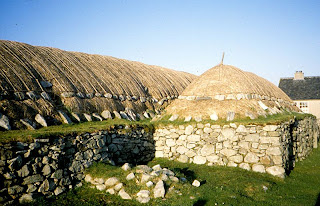Territory; I touched upon previously the territorial rights in the small yard at Whitby at the moment I am reading
Adam Nicholson's Sea Room, this a book about three small islands called the
Shiants just off, or at least 4 miles from the larger island of Lewis, surrounded by rough seas and the tide-ripes of the Minches, it is difficult to get to and difficult to live on, sheep are the only livestock, but in days past there would have some crofters living there as on St.Kilda.
The islands were brought in the early 20th by Adam Nicholson's father from Compton Mackenzie, inherited by Adam and to be passed on his son in due course but of course to some locals, it was not 'owned' by an English family. This understanding rests lightly on the warring factions of the Scottish tribal or clan system, though strangely the Nicholson family had earlier claimed dominance on the islands as Vikings in the 12th century. Eight generations of landlords, Compton Mackenzie had bought the islands from an earlier English landlord Lord Leverhulme, who also owned the Isles of Lewis and Harris. Of course this state of affairs of large Scottish estates owned by outsiders still exist, nothing much changes.
What caught my eye though was a statement by the Reverend Donald MacCullum in 1894 when he made an impassioned plea to the Royal Commission who was hearing the state of the crofters in the island, it was a very emotional attack on 'landlordism' and its existence, but it gives a state as to how local people feel confronted by outsiders who take possession of their lands....
have necessarily resulted from the fact that land, lake, river and estuary are appropriated to the sole use, and regulated by the will of a few irresponsible individuals styled by themselves and others as lords. Every man has a right, natural and god-given to the earth and its fullness - its fullness of light, air and water. of vegetation and fruit, of beast, bird and fishes, of metals and minerals. The lords who first sold the land had no right to do so and therefore the lords who bought the land are not the owners thereof. That which a man has no right to sell cannot become the property of the man who buys it.
He goes on to say....
Lordism impoverishes the land. The wealth that is on sea and land, instead of being used in rearing the families of those who earn it, is spent in providing luxuries for idle lords..
Well obviously he did not win his case but the hostility occasioned to landlords is probably justified when your background is Scottish or Irish, the appropiation of land by force whether Saxon, Norman or the dissolution of the monastic houses and their lands falling into the hands of rich entrepreneurs in England are again echoed by the wealthy 19th century industralists who with money in their pockets, land grabbed and forced people from their settlements in Scotland laying waste the land to deer and birds for shooting by the wealthy.......




















.jpg)

















